Archive for September 12th, 2022
» posted on Monday, September 12th, 2022 by Linda Lou Burton
Didn’t Miss A Thing
Linda Lou Burton posting from Sweetwaters Serena Camp, Ol Pejeta Conservancy, Nanyuki, Kenya – Ever get to a place and just want to stay forever? Ever sit on a front porch and just breathe, content to do absolutely nothing? Ever had guinea fowl make such a racket you stood up to look for invaders in your yard? Believe it or not, all those things happened to me, and to Rick, in our first hour at Tent #16, Sweetwaters Serena. I’d never even heard of guinea fowl before! More precisely, I’d never HEARD guinea fowl, but that awful sound got us up and looking for the problem.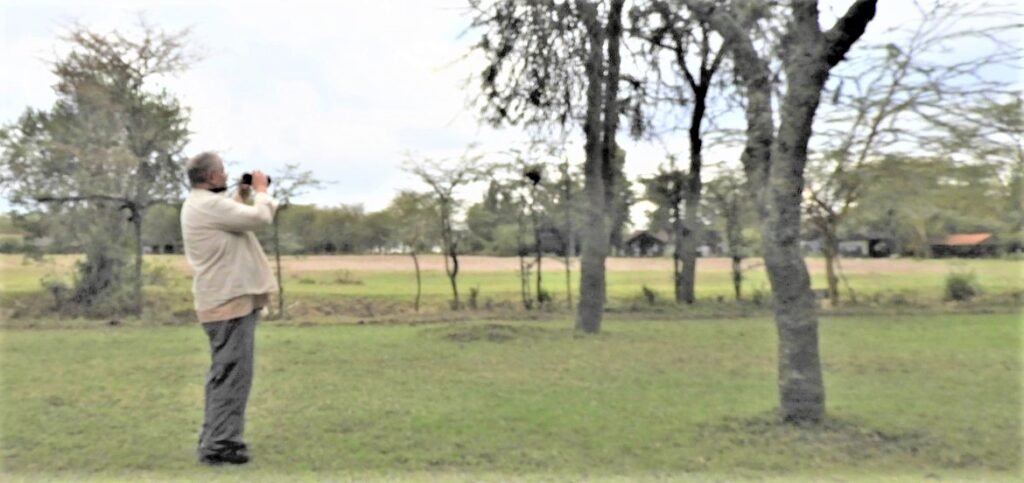
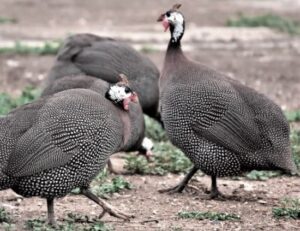 The porch of our fancy-schmancy tent faced the water hole, a distance away past the tree line. And something over there was excited; it sounded like dogs-with-a-terrible-cold barking. Use your expertise to google “guinea-fowl sounds” and you’ll see what I mean. That’s what Rick did, as we finally spotted the “helmeted chickens” all in a fuss about something. They are known as “alarmists” and considered useful (on a farm, or a wildlife preserve?) for sensing trouble.
The porch of our fancy-schmancy tent faced the water hole, a distance away past the tree line. And something over there was excited; it sounded like dogs-with-a-terrible-cold barking. Use your expertise to google “guinea-fowl sounds” and you’ll see what I mean. That’s what Rick did, as we finally spotted the “helmeted chickens” all in a fuss about something. They are known as “alarmists” and considered useful (on a farm, or a wildlife preserve?) for sensing trouble.
All that activity got Rick excited to see more animals, so he headed off to meet Abdi and Daniel and Frank and the rest of the gang for the very first Game Drive. In those 4x4s. Eek! “I’m not going anywhere!” I said. “A 5:30 wakeup today! A 5-hour drive with all that bumping and jabbering! I’m taking a NAP.”
 Ahhh, peace and quiet. The guinea fowl settled down. The rain began, the kind of rain that politely falls without a mess, and whispers you to sleep. I headed inside. I’ve done some camping in my day. I’ve slept in pop-up tents, with sleeping bag on the ground, campfire for cooking, and potty relief behind the nearest tree. My Sweetwaters tent was nothing like THAT. It’s called a “permanent tent” set up on a concrete (tiled and carpeted) floor, with a permanent thatched roof above.
Ahhh, peace and quiet. The guinea fowl settled down. The rain began, the kind of rain that politely falls without a mess, and whispers you to sleep. I headed inside. I’ve done some camping in my day. I’ve slept in pop-up tents, with sleeping bag on the ground, campfire for cooking, and potty relief behind the nearest tree. My Sweetwaters tent was nothing like THAT. It’s called a “permanent tent” set up on a concrete (tiled and carpeted) floor, with a permanent thatched roof above.
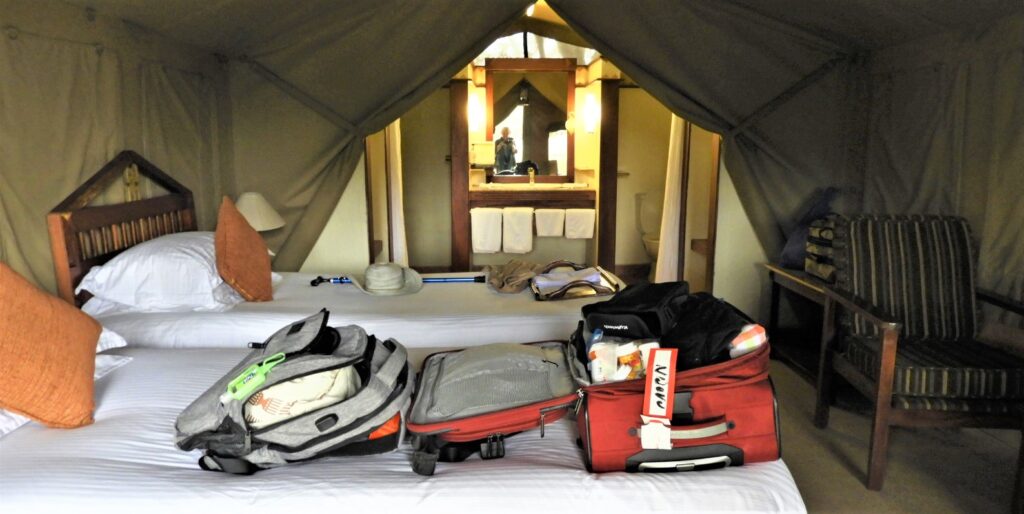 Sweetwaters Serena has 56 such tents; some are on raised platforms with balconies; ours was nearer the water hole, with a porch. Two comfy double beds. Two closets. Two robes. Two chairs inside; two out. Wi-fi and coffee station. Bath with tile shower, flush toilet, stacks of towels. Electricity! It qualified as “tented camping” because, in fact, all of this WAS inside a (very well protected) canvas tent. With windows and doors that zipped open, and closed. I left the door unzipped, and went to sleep with nary a dream of being devoured by a lion, as those who’ve-never-been-to-Africa predicted would be my demise.
Sweetwaters Serena has 56 such tents; some are on raised platforms with balconies; ours was nearer the water hole, with a porch. Two comfy double beds. Two closets. Two robes. Two chairs inside; two out. Wi-fi and coffee station. Bath with tile shower, flush toilet, stacks of towels. Electricity! It qualified as “tented camping” because, in fact, all of this WAS inside a (very well protected) canvas tent. With windows and doors that zipped open, and closed. I left the door unzipped, and went to sleep with nary a dream of being devoured by a lion, as those who’ve-never-been-to-Africa predicted would be my demise.
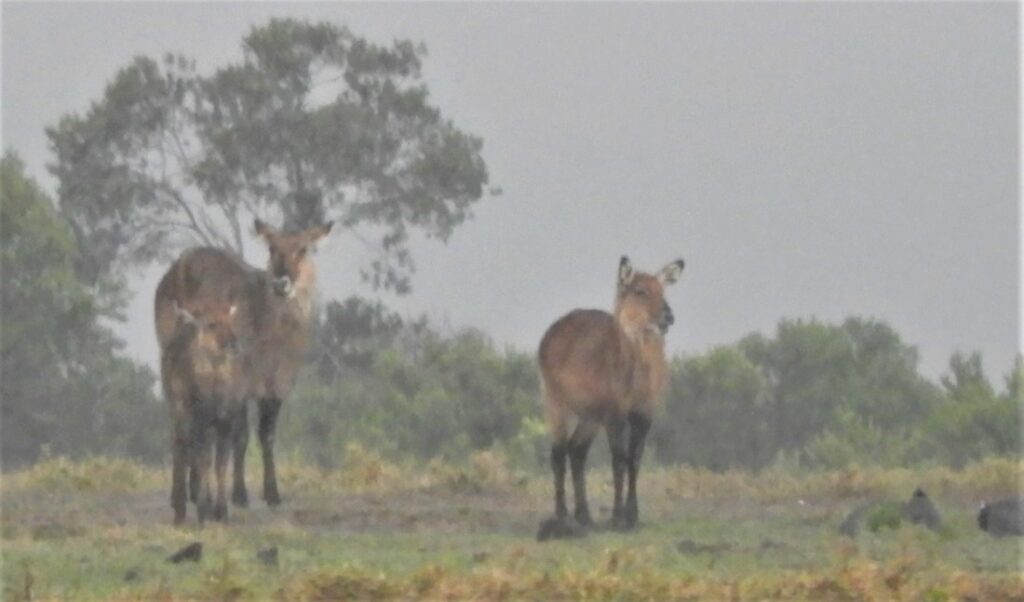 An awful squawking woke me. I’d slept an hour or so, felt rested now. I walked to the porch; a misty fog replaced the rain. I couldn’t see the water hole; zoomed my camera; caught something moving far away. It was a mother and baby impala (I think, white ears rimmed in black), with a younger impala standing peacefully beside. Coming up on the right I could see the squawking guinea fowl.
An awful squawking woke me. I’d slept an hour or so, felt rested now. I walked to the porch; a misty fog replaced the rain. I couldn’t see the water hole; zoomed my camera; caught something moving far away. It was a mother and baby impala (I think, white ears rimmed in black), with a younger impala standing peacefully beside. Coming up on the right I could see the squawking guinea fowl.
The gang would be back from their Game Drive soon, I realized. Dinner in the Rhino Room began at 7; everybody chattering; what they saw; what they did; what I missed.
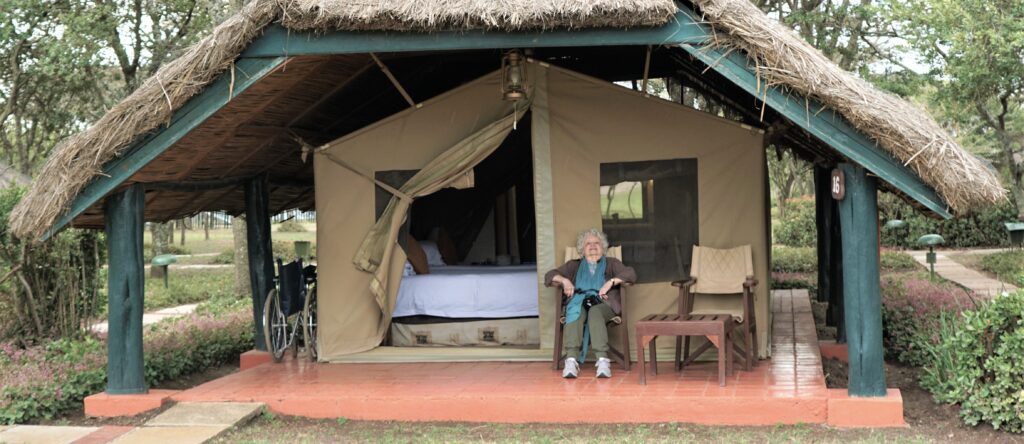 I didn’t miss a thing. There’s just something about a porch.
I didn’t miss a thing. There’s just something about a porch.
Sweetwaters Serena, Ol Pejeta Conservancy, Kenya https://www.serenahotels.com/sweetwaters
» posted on Monday, September 12th, 2022 by Linda Lou Burton
Better Than Disney
Linda Lou Burton posting from Sweetwaters Serena Camp, Ol Pejeta Conservancy, Nanyuki, Kenya – Ol Pejeta Conservancy is – well, it’s better than Disneyland! For animal lovers – it offers more than any zoo you’ve ever been to. For nature lovers – it offers more change of scene than any hike you’ve ever walked in the remotest of hills. For sheer accomplishment and impact, well, read on, in fact, go to THEIR website and spend the day learning about this magnificent place on the Equator in the foothills of Mt Kenya. https://www.olpejetaconservancy.org/
 Here are a few basics about Ol Pejeta.
Here are a few basics about Ol Pejeta.
- It’s a not-for-profit wildlife conservancy in Central Kenya’s Laikipia County, providing “innovative, tangible, sustainable conservation for wildlife and people.”
- It’s big, and broad – 90,000 acres containing 4 key habitats (plains, riverine, wetlands and mixed acacia bushland), hundreds of species and thousands of animals, and is surrounded by a population of more than 50,000 people.
- It’s home to the Big Five – lion, leopard, elephant, cape buffalo, and rhinoceros – as well as giraffes, hippos, hyenas, baboons, and endangered species like the African wild dog, cheetah and oryx.
- It’s the largest black rhino sanctuary in East Africa, with a population of over 140 black rhinos, a critically endangered species.
- It’s home to the world’s last two remaining northern white rhinos. Najin, 32, and her daughter Fatu, who is in her twenties, live in a 700-acre 24-hour secured enclosure. The last male of the species, Sudan, died in 2018.
- It’s the only place in Kenya to see chimpanzees, in a sanctuary established to rehabilitate animals rescued from the black market.
- It’s home to a herd of 6,000 bush-savvy purebred Boran cattle. Livestock-wildlife integration is beneficial to the grassland as bunched grazing breaks hardpan soil and fertilizes the ground.
- It’s supporting the people living around its borders through infrastructure and economic projects and education and healthcare efforts.
Good news for you, and me, Ol Pejeta welcomes and embraces visitors! It offers nine tented camps (Globus booked us into Sweetwaters Serena), lodges and homestays, and five campsites. Do you want pampered luxury and table-waited dining, or camping in the wild (you know, those middle-of-the night sounds when animals scratch around your tent)? Either way, you’ll wake up surrounded by NATURE, with the chance of more adventure than, well, that other place I mentioned.
And the RIDES at Ol Pejeta are in open-air 4x4s splashing through rocky creekbeds in pursuit of the latest reported elephant sighting, or pausing to watch a baby rhino and its mom feeding in the quiet of wide-open spaces, or the dark of night when the spotter’s light catches a lion couple in repose.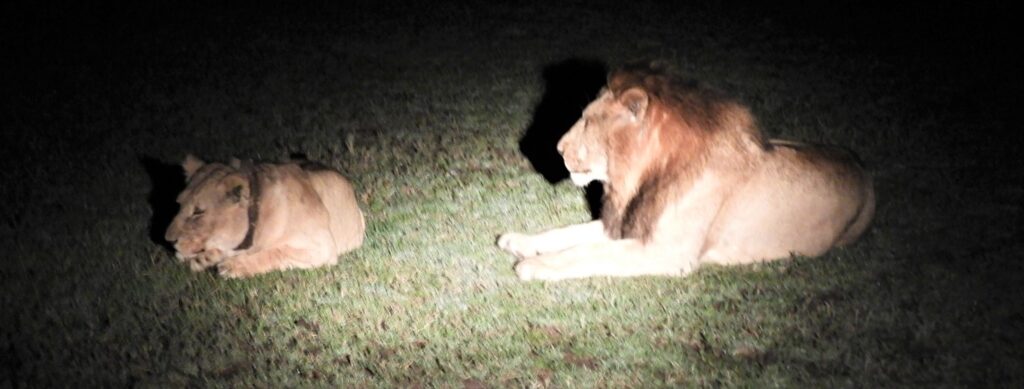
It’s a Trip Advisors Travelers Choice again this year, and 100% of profits from tourist dollars are reinvested into conservation and community development. A visit isn’t just good for you, it’s good for Kenya’s natural heritage, and its people.
The Animals: Ol Pejeta Wildlife https://www.olpejetaconservancy.org/wildlife/
The Projects: Ol Pejeta Conservation https://www.olpejetaconservancy.org/conservation/
Places to Stay and Things To Do: Ol Pejeta Escapes https://www.olpejetaconservancy.org/ol-pejeta-escapes/
Get Involved Wherever You Are: https://www.olpejetaconservancy.org/get-involved/
» posted on Monday, September 12th, 2022 by Linda Lou Burton
Hurry Up and Wait
Linda Lou Burton posting from Sweetwaters Serena Camp, Ol Pejeta Conservancy, Nanyuki, Kenya – Hurry up and wait! That’s what you do, when you’re on a trip, especially  when it’s planned by somebody else. Wait for instructions. Hurry to be on time. Then wait for everyone else to show up. Keep looking back to see what you forgot. Blink a lot. Meet the guide. Meet the gang. Check out. Where is our
when it’s planned by somebody else. Wait for instructions. Hurry to be on time. Then wait for everyone else to show up. Keep looking back to see what you forgot. Blink a lot. Meet the guide. Meet the gang. Check out. Where is our 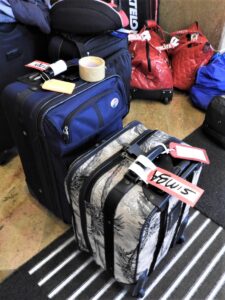 luggage? Which van do we get in? And that was just the beginning of our last day in Nairobi.
luggage? Which van do we get in? And that was just the beginning of our last day in Nairobi.
Our Monday morning wake-up call: 5:30 AM. Take turns in the bathroom; clothes laid out the night before, in order. Who could think, so early? Money belt with passport inside the first thing to put on, shoes the last. Who could eat so early? But we did. We had an organizational meeting at 7:00; notice given the night before that we were LEAVING TOWN by 8:00.
Of course we didn’t. In a room near the lobby we met Abdi, our Safari Guide. ABDI! Our Leader, our Teacher, our Troubleshooter, our Pit Boss for the next weeks. Our Expert-on-Africa. He went over the rules, the plans, the expectations. He introduced our drivers. DANIEL, our driver from yesterday, well yea, Rick and I were pleased about that. FRANK, a tall, humorous young man who stood up to say “I’m not Sinatra!” Then introductions around the circle: Otis and Venita (from Texas); Mike and Lois (from Texas); Judy (from Texas). Ed and Maureen broke the streak – they claimed Kentucky as home; Rick Washington; me Arkansas. I was the oldest in the 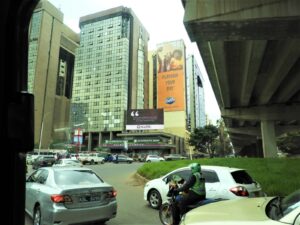
 group. “Have Cane, Will Travel,” I said.
group. “Have Cane, Will Travel,” I said.
Out front, confusion. My bag was tagged SIMBA, to match the picture of the lion taped to the window of our 4×4. We were blurry, confused, scrambling for seats. And then we were gone! It was 8:49 as we headed out the guarded gate of the Nairobi Serena. Downtown we passed under the freeway, turned on A2 by the Co-operative Bank (is there an un-cooperative bank?). Morning traffic rush, cars headed in, matatus (those vividly decorated private buses) whizzing out, cattle marching along the edge. I’d studied the maps months earlier so I’d know what to expect once we left the city.
I knew it was 130 miles to Sweetwaters Serena, our first tent-camp. A 4-hour drive, according to Google. I had my list of towns we’d pass through, how fun, I thought, to see the countryside!
- RUIRU. Population 490,120. Altitude 5,135 feet. Once a coffee-growing area; now mostly housing.
- THIKA. Population 279,429. Altitude 5,351 feet. A major commercial hub. Ol Donya Sabuk National Park near.
- MURANGA. Population 110,000. Altitude 4,120 feet. Traders and farmers here; a busy matatu terminal.
- SAGANA. Population 13,000. Altitude 5,450 feet. Tourist attractions along the Sagana River.
- KARATINA. Population 6,852. Altitude 6,129 feet. Largest open-air market in Kenya. Residents 90% Kikuyu.
- NANYUKI. Population 49,233. Altitude 6,250 feet. On the Equator, the base for people climbing Mt Kenya.
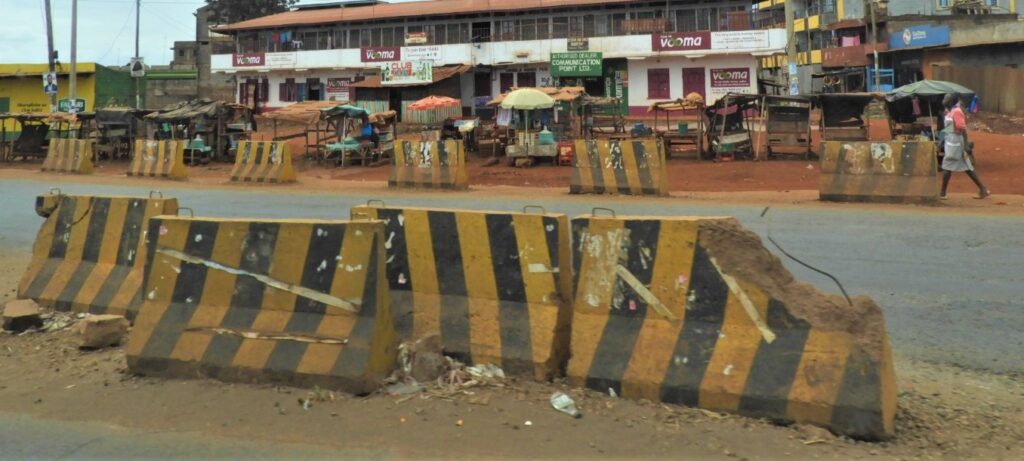 Now here is where expectations met reality. A2 was bumpy, dusty, rigged with speed bumps at every commercial spot. “The Sleeping Police,” Daniel explained to us as he slowed. Again, and again, and again. I clung to the strap, I was third row back in the 4×4 and my seat belt kept slipping. I banged my head against the window; tried to focus on the passing scene.
Now here is where expectations met reality. A2 was bumpy, dusty, rigged with speed bumps at every commercial spot. “The Sleeping Police,” Daniel explained to us as he slowed. Again, and again, and again. I clung to the strap, I was third row back in the 4×4 and my seat belt kept slipping. I banged my head against the window; tried to focus on the passing scene.
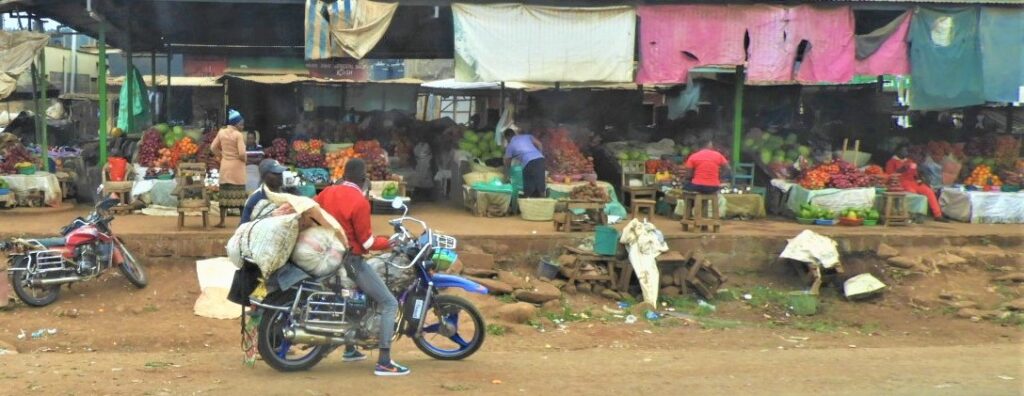 The markets were busy, swarming with people, motorbikes, bananas, tomatoes, melons, produce of every kind. There was commerce going on; action, color, noise. Inside our vehicle, Abdi called our attention to points of interest — the Teachers College, the river, the papaya trees. “Wow!” was repeated, endlessly, by one of our gang. “Wow!” to the Teachers College. “Wow!” to the river. “Wow!” to the papaya trees. I got a headache.
The markets were busy, swarming with people, motorbikes, bananas, tomatoes, melons, produce of every kind. There was commerce going on; action, color, noise. Inside our vehicle, Abdi called our attention to points of interest — the Teachers College, the river, the papaya trees. “Wow!” was repeated, endlessly, by one of our gang. “Wow!” to the Teachers College. “Wow!” to the river. “Wow!” to the papaya trees. I got a headache.
 A short stop at a souvenir shop. I didn’t want to shop. Daniel brought me a chair and a coke while the others bartered for elephants carved out of wood and paintings that would roll up for shipping (we can ship anything direct to your house). Finally, (finally!) back on the road; the scene more rural now; simple roadside stands and fertile farmland.
A short stop at a souvenir shop. I didn’t want to shop. Daniel brought me a chair and a coke while the others bartered for elephants carved out of wood and paintings that would roll up for shipping (we can ship anything direct to your house). Finally, (finally!) back on the road; the scene more rural now; simple roadside stands and fertile farmland.
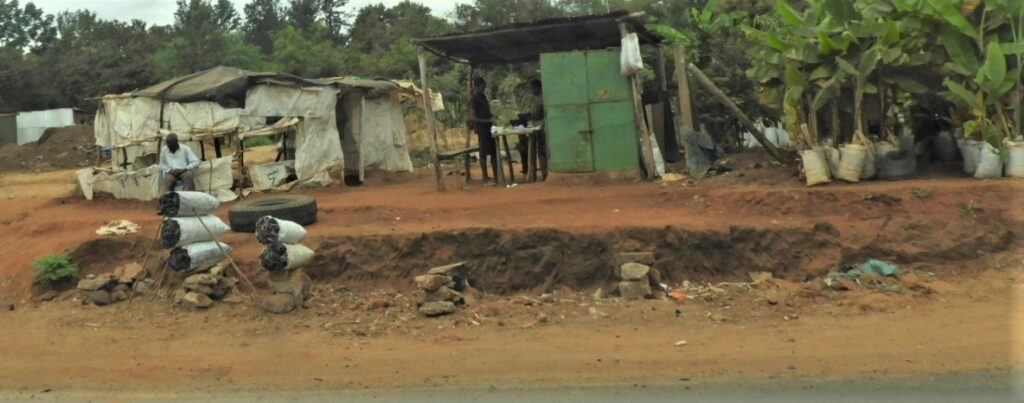 We passed small family plots with tin-roofed barns; we passed huge open fields stretching for miles towards Mt Kenya in the east. We passed Maisha Flour Mills, with its giant grain silos. I asked Abdi about the main products that come out of Kenya; the answer surprised me — concrete, flowers, wheat.
We passed small family plots with tin-roofed barns; we passed huge open fields stretching for miles towards Mt Kenya in the east. We passed Maisha Flour Mills, with its giant grain silos. I asked Abdi about the main products that come out of Kenya; the answer surprised me — concrete, flowers, wheat.
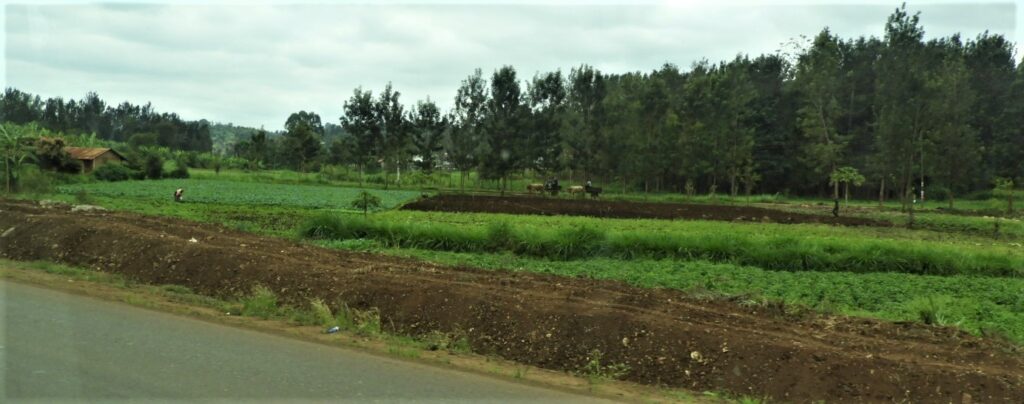 And then we were in Nanyuki; a big yellow sign splashed out the news: You Are At The Equator! We begged to stop; but it was almost 1:30 then, and lunch was waiting at the camp. “We’ll get pictures on the Equator tomorrow,” Abdi promised.
And then we were in Nanyuki; a big yellow sign splashed out the news: You Are At The Equator! We begged to stop; but it was almost 1:30 then, and lunch was waiting at the camp. “We’ll get pictures on the Equator tomorrow,” Abdi promised.
 Daniel made a left onto Nanyuki-Marura Road. It was lined with tiny shops; a hardware store (Sand Blast & Ndarugo?); corrugated housing in a row, chickens wandering out front.
Daniel made a left onto Nanyuki-Marura Road. It was lined with tiny shops; a hardware store (Sand Blast & Ndarugo?); corrugated housing in a row, chickens wandering out front.
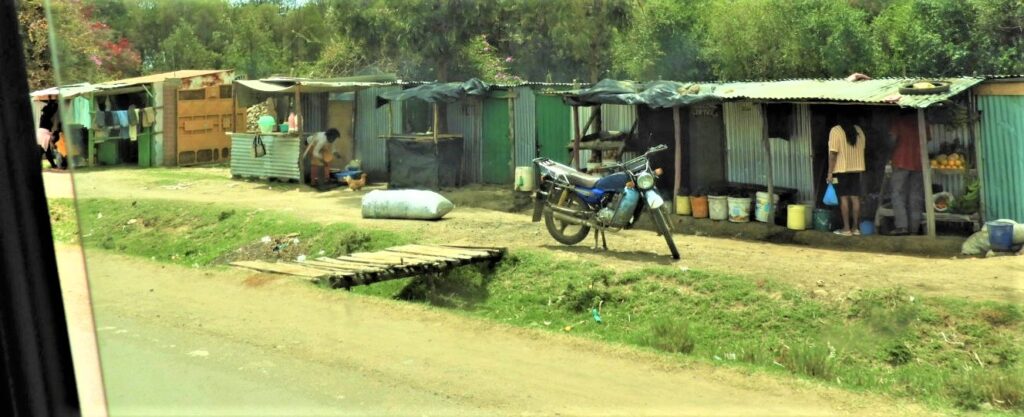 It was 1:49 when we reached Ol Pejeta Conservancy, where our tented camp was located. You’d better keep reading my posts, because this place is going to knock your socks off.
It was 1:49 when we reached Ol Pejeta Conservancy, where our tented camp was located. You’d better keep reading my posts, because this place is going to knock your socks off.
Some things are absolutely worth the wait.

